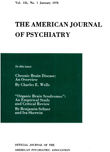ARCHETYPAL PATTERNS IN SCHIZOPHRENIA
Abstract
The purpose of this paper is to present briefly Jung's theory of archetypes and to illustrate it with specific case material. An archetype is described as an inherent pattern of psychic function common to all human beings and thought to be inherited with the brain structure. Archetypes present themselves in unconscious symbolism as certain characteristic recurring themes and figures of a mythological nature. Since religions and mythologies come from the same unconscious source as dreams and delusions, we find the same basic archetypal themes appearing in all such unconscious productions. Thus schizophrenic delusions are found to show many parallels with religious and mythological symbolism.
The conscious ego of the schizophrenic has been overwhelmed by these archetypal contents and the patient often identifies himself with such suprapersonal figures as the mythological hero or the religious savior. Such figures represent basic forces of life which are collective or social in nature and transcend the individual ego. Any attempt to appropriate them for personal aggrandizement leads to alienation from reality.
Access content
To read the fulltext, please use one of the options below to sign in or purchase access.- Personal login
- Institutional Login
- Sign in via OpenAthens
- Register for access
-
Please login/register if you wish to pair your device and check access availability.
Not a subscriber?
PsychiatryOnline subscription options offer access to the DSM-5 library, books, journals, CME, and patient resources. This all-in-one virtual library provides psychiatrists and mental health professionals with key resources for diagnosis, treatment, research, and professional development.
Need more help? PsychiatryOnline Customer Service may be reached by emailing [email protected] or by calling 800-368-5777 (in the U.S.) or 703-907-7322 (outside the U.S.).



